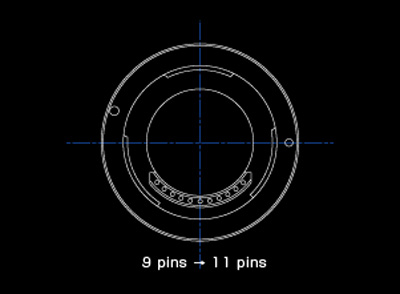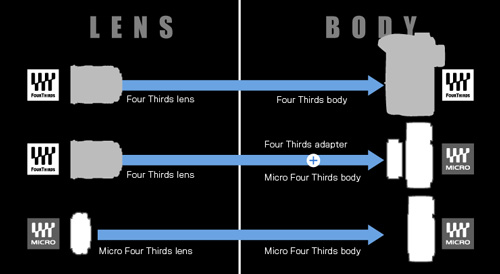Panasonic G1: Smallest and Lightest Interchangeable Lens Digital Camera
by Wesley Fink on September 15, 2008 1:00 PM EST- Posted in
- Digital Camera
What is Micro Four Thirds?
It is important to understand that Micro Four Thirds uses the exact same sensor as four thirds; there is no size reduction in the sensor. When compared to the Four Thirds System standard, the primary differences in the Micro Four Thirds System are:

- Approximately 50% shorter flange back distance (mount-to-sensor distance): With the optical SLR viewfinder replaced by an LCD or EVF (electronic view finder) - or both - the mount to sensor distance can be cut in half. This allows the lens to be designed without a back-focus requirement, which also greatly reduced the size.

- 6mm smaller lens mount outer diameter: Without the need for so much back-focus in lens designs for Micro Four Thirds, the diameter of the lens flange can be reduced, while still allowing designs for parallel light paths.

- Electrical contacts in mount increased from 9 to 11: With viewfinder optics replaced by electronics, more electronic interfaces to the lens are required.
When the standard was announced, Olympus and Panasonic emphasized the compatibility of Micro Four Thirds with the current Four Thirds system and lenses. Micro Four Thirds, like Four Thirds, is also an open system that can be licensed by any manufacturer who wishes to use it.

Four Thirds Compared
The Four Thirds standard is one of the smaller of the formats based on APS-C, but it is still about 75% of the area of the Canon XSi. However, compared to P&S sensors the Four Thirds sensor is huge.
| DSLR Sensor Comparion | ||||
| Camera | Effective Sensor Resolution |
Sensor Area and Dimensions | % of Full-Frame | Sensor Density (MP/cm2) |
| Olympus SP-579UZ | 10.0 | 6.13x4.60 0.28 cm2 |
3.20% | 36 |
| Canon G9 | 12.1 | 7.60x5.70 0.43 cm2 |
5.10% | 28 |
| Panasonic G1 | 12.1 | 13.5x15 2.43 cm2 |
28.10% | 4.98 |
| Olympus E-520/E-3 | 10.0 | 13.5x18 2.43 cm2 |
28.10% | 4 |
| Canon XSi | 12.2 | 14.8x22.2 3.28 cm2 |
38.00% | 3.7 |
| Sony A350 | 14.2 | 15.8x23.6 3.72 cm2 |
42.90% | 3.8 |
| Pentax K20D | 14.6 | 15.6x23.4 3.65 cm2 |
42.20% | 4 |
| Canon 50D | 15.1 | 14.9x22.3 3.32 cm2 |
38.40% | 4.5 |
| Sony A700, Nikon D300, Nikon D90 | 12.3 | 15x23.5 3.66 cm2 |
42.40% | 3.3 |
| Nikon D700/Nikon D3 | 12.1 | 24x36 8.64 cm2 |
100% | 1.4 |
| Canon 5D | 12.7 | 24x36 8.64 cm2 |
100% | 1.5 |
| Canon 1Ds Mark III | 21.1 | 24x36 8.64 cm2 |
100% | 2.4 |
| Sony A900 | 24.6 | 24x35.9 8.61 cm2 |
100% | 2.9 |
If you have any doubt why the photo market has been moving to DSLR from P&S you have only to look at the last column detailing sensor density. At 12.1MP, the new Panasonic G1 will establish a new density high in the DSLR market at almost 5MP per cm2. However, the top-of-the-line Canon G9 P&S at 10MP has a tiny sensor by comparison and the density is 28 MP/cm2. The Olympus Super Zoom SP-570UZ is even worse at 36 MP/cm2.
The motivation for Micro Four Thirds should be crystal clear in this chart. Panasonic and Olympus are trying to extend their Four Thirds sensor technology to higher-end, higher-quality, but very small and pocketable interchangeable lens cameras. These new cameras will feature large hi-res LCD screens, full time Live View, and fast contrast-detect focusing. The top ones will also feature hi-res EVF, and video capabilities are mentioned in the Micro Four Thirds standard. It should be clear the idea is a new bridge technology that brings DSLR features, P&S features, and camcorder features together in a more compact and cheaper camera body. In doing this they will create a new camera class, or chart directions for future interchangeable lens cameras, depending on market acceptance.










20 Comments
View All Comments
aeternitas - Monday, September 15, 2008 - link
I agree. Thats something they should use as a selling point more than anything else about the camera.aeternitas - Monday, September 15, 2008 - link
Them going on and on about how 'smooth' and 'accurate' ect ect this thing is and not mentioning the actual size of the CCD makes me roll my eyes.It’s pretty obvious to me this is a stunt to create some new type of camera sector. Compact SLR? Give me a break. That doesn’t even make any sense! By definition you’re going to have a lens, even if prime, that’s not going to fit comfortably in your pocket! Not only that, but if the camera itself is too light the lens will make it unbalanced on a tripod and in hand. I hope they were at LEAST smart enough to put the tripod threading further up closer to the lens itself under the camera, but that doesn’t change the in-hand issue.
If you think it’s a non-issue then you’re better off with a PoS camera, because SLRs are made to be comfortable through 1000s of images taken in a days’ time. Your hands will start to hurt, and isn’t that kind of contradictory to the purpose of this camera? Comfort? Or is there another purpose? I don’t really understand the point of this.
Let’s not forget the most important thing; Even the best consumer SLRS with full frame CCDs and superb SnR cannot resolve the resolution of the glass in front of them. What is the POINT of putting glass that even those cameras cannot resolve in front of this? It’s like putting 8GB of ram into a system that can only see 3.5.
Unless this thing is like 300$, it’s sort of an insult to any photographer with half a wit.
aeternitas - Monday, September 15, 2008 - link
I’d like to correct that the CCD was mentioned, skipped a page. My mistake. My point is made clearer though, as the pixel density is 5.Wesley Fink - Monday, September 15, 2008 - link
Yes, the pixel density is 4.98 MP/centimeter square as we pointed out, but the New Canon 50D is 4.5 which is not a hyge difference. You missed the point that the P&S densities are 28 to 36 MP per square centimeter which are a huge density difference compared to 4/3.In fact all of the APS-C sensors are all but the same when you look at the huge density advantage they hold over the best of today's point-and shoot models. Frankly people need to get past the emotion over the 4/3 sensor size and look at the facts, which are nowhere near the stark picture some like to paint. The 4/3 sensor is 75% the area of the the Canon sensor, and 6 to 8 times larger than the best P&S sensors.
Ajax9000 - Monday, September 15, 2008 - link
"Frankly people need to get past the emotion over the 4/3 sensor size ..."Agreed.
The smaller sensor in FT is claimed to be the equvilant of about 0.5-1 stop slower than the larger sensors in "conventional" dSLRs, but as can be seen with the Zuiko ED 12-60mm, the FT mount can enable faster lenses for a given size -- i.e. negating the supposed disadvantage. Lenses for mFT should be the same or better.
[quote]
Olympus ... have taken advantage of the Four Thirds sensor to deliver lenses which, for any given size, weight and cost, simply perform to a higher and more consistent standard than those optimized for larger formats ... The relatively fast maximum aperture (a half to a full stop faster than APS-C equivalents ...), coupled with the excellent wide-open performance, also allows the use of lower ISOs at equivalent light levels for maximum image quality.
[/quote]
From http://www.dpreview.com/lensreviews/olympus_12-60_...">http://www.dpreview.com/lensreviews/olympus_12-60_...
aeternitas - Monday, September 15, 2008 - link
The beef I have with this type of deal is there is no point. Honestly what’s the point? You can’t fit this anywhere a normal DSLR couldn’t go. It’s a diluted mix of SLR and point and shoots taking the worst qualities from each. Too big to be put anywhere advantageous over a normal DSLR and worse than even some of the worst pixel densities in the DSLR market.When you say it’s nowhere near the bad picture some people paint, you put yourself in a category of 'good enough'. People that spend 1000$ on glass and camera equipment do not do 'good enough' they do not want gimmicks. This is such a gimmick camera. The only interesting feature with practical use is that the glass is closer to the CCD.
Like I said, they can word things in a way to make the practical aspects of teh camera that are bad, sound good, but in the end they need to stop it and focus on the true pluses of this design.
strikeback03 - Monday, September 15, 2008 - link
The G1 at least is very similar in dimensions to the superzoom-class P&S cameras, and body-only similar in size to something like the Canon G9. So while this should take a big bite out of the superzoom market (at least once the micro 4/3 14-140 lens drops), I don't really consider it "pocketable". We have a couple of Canon S5IS cameras here in the lab, with the exception of large cargo pockets or maybe a pullover hoodie I don't have any pockets which could hold something that size comfortably. So if I am bringing some sort of camera bag anyway I don't see the problem with stepping up to the smaller traditional DSLRs from Olympus, Canon, Pentax, etc. But it will give Panasonic something different in the marketplace.tdawg - Monday, September 15, 2008 - link
Being so small, yet packing potentially high level image quality, would be nice for hiking and camping where one doesn't want to haul a more traditially-sized SLR and lenses, I would think. Also potentially nice for people that like to sneak camera gear into concerts and such. :)Personally, I don't like non-optical viewfinders on my SLRs, but as long as it has a viewfinder in addition to the rear LCD, it might not be too bad. The problem is that I can't see myself investing any money in any system other than my current Nikon system, so...
aeternitas - Monday, September 15, 2008 - link
"Haul"? Are you serious? This thing maybe weighs 2-300GRAMS less than a proper DSLR. If you can't handle 300grams to take obviously better photography you might as well use your cameraphone with that line of thought.expiringfrog - Wednesday, September 24, 2008 - link
I'm not sure how you conclude that a DSLR will take "obviously better photography (sic)". The G1 sensor is the same size as those used in all of Olympus' range of "proper DSLR's". Wesley points out quite correctly that this is not much smaller than 35mm full-frame and has perfectly decent imaging characteristics, certainly far better than the fingernail-sized sensors used in typical compact cameras. So this is certainly comparable to a "proper DSLR" in image quality. As for handling and speed, it all depends on what type of pictures you want to take: this isn't something you'd normally use to shoot motorsports, but on a hike it's as good as any DSLR, and will only get better as technology progresses.As for the weight difference of 300 grams, you've never met a serious hiker, have you?